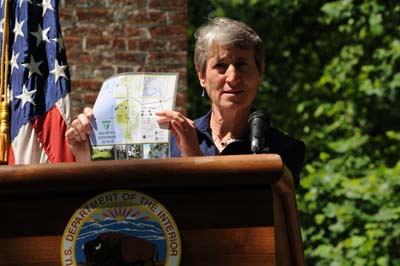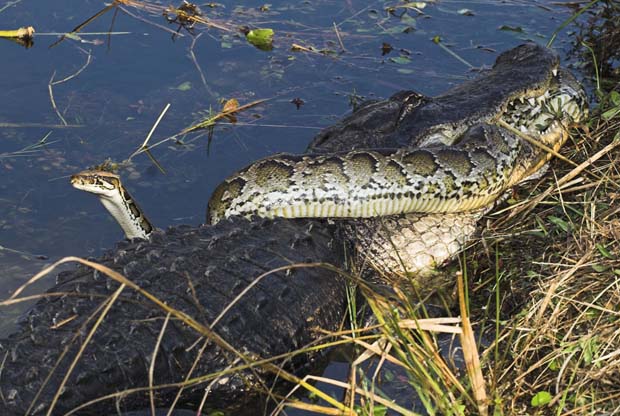
Interior secretary: Hill funding divide could threaten national parks

Interior Secretary Sally Jewell and Rep. Steny Hoyer (D-Md.) on Friday (5/22) tour the Douglas Point Recreation Area, on Maryland’s Potomac River shoreline 40 miles south of Washington. (Tami Heilemann/ U.S. Dept. of the Interior)
by Joby Warrick
[dropcap]A[/dropcap] government fund that has helped preserve some of the nation’s most iconic parks – from Gettysburg’s battlefields to the Everglades and the Appalachian Trail – could disappear as early as fall because of a congressional dispute over how the program’s revenue should be spent, U.S. officials warn.
The federal Land and Water Conservation Fund (LWCF) has been used for 50 years to acquire land deemed to have special historical or environmental significance. Although the fund is popular with lawmakers from both political parties, legislation needed to keep the program alive appears to have stalled.
The law that created the program is set to expire in September, putting at risk a primary source of revenue for the nation’s largest preserves as well as state parks and community playgrounds and ballfields. The money – capped at $900 million annually but substantially smaller in most years – comes not from tax revenue but from royalties paid by oil and gas companies for drilling rights in federal waters offshore.
“Absolutely, there’s a risk that this could go away,” Interior Secretary Sally Jewell said in an interview. Jewell said that although the program has traditionally drawn heavy bipartisan support – the law that created the fund in 1964 had only one dissenting vote – a bill that would reauthorize the fund faces significant opposition from lawmakers who either are ideologically opposed to federal land acquisition or have other ideas for using the money.
“Anything that looks like a chunk of money that you can use for your other projects, some will want to go for it,” she said.

On Friday (5/22) at Douglas Point Recreation Area in Maryland, Interior Secretary Sally Jewell describes purchases of park land in southern Maryland under the Land and Water Conservation Fund. (Photo by Tami Heilemann/ U.S. Dept. of the Interior)
A failure to renew the fund could jeopardize improvement projects at hundreds of sites across the country at a time when many of the nation’s most popular parks face budget shortfalls and deferred maintenance. While Congress has frequently sparred over the fund’s size, the current impasse is regarded as the most serious threat to the program’s survival since its inception during the Lyndon B. Johnson administration.
Jewell, whose department administers the fund, has made visits to parks across the South and Mid-Atlantic in recent weeks seeking to build political support for the reauthorization effort. On Friday, she toured the Douglas Point Special Recreation Area, a small nature preserve on Maryland’s Potomac River shoreline that was purchased with money from the LWCF.
The federally owned, 500-acre tract is part of a larger wilderness area that includes Maryland’s Purse State Park and a conservation preserve purchased by the Nature Conservancy, an environmental nonprofit group. The combined area encompasses one of the region’s largest remaining stands of mature hardwood forest, and the shoreline is a popular stopping point for kayakers and collectors who scour the beach for the fossilized teeth of ancient sharks and crocodiles.
The spot was once considered a potential site for a rock quarry or a nuclear power plant, and more recently the area was eyed by developers for private waterfront housing. In 2001, money from the LWCF was used to buy the tract to safeguard its natural treasures while ensuring public access to a scenic area that is almost exclusively in private hands, said Joel Dunn, president of the Chesapeake Conservancy, an environmental nonprofit group based in Annapolis.
“With 98 percent of the Chesapeake’s shoreline being privately owned, the parks and recreation areas that were created with LWCF, or state open-space funds, are the only reasons I can connect with the resource,” Dunn said. “We’ve got a population in this region approaching 18 million and climbing, and we’re losing tens of thousands of acres of open space each year. We are literally racing against the tide.”
Resistance to renewing the program comes from Republican lawmakers who argue that the federal government should get out of the land-acquisition business. Some senior Republicans have called for selling much of the federal government’s holdings to states or private entities. Others, including Senate Energy and Natural Resources Committee Chairman Lisa Murkowski (R-Alaska), say that the LWCF should be restructured as a maintenance fund to pay for repairs to parks.
“I strongly believe that conservation in the 21st century must include taking care of what we already have – what we chose to conserve first – instead of simply pretending that ‘more is always better,’ ” Murkowski said at an April Senate hearing.
But other lawmakers, including a number of prominent Republicans, strongly support the fund, which has provided revenue for recreational projects popular with constituents. Tens of millions of dollars each year go to matching-funds programs to acquire and develop state and local parks, including soccer fields and playgrounds. On the federal level, the fund has supported land purchases in nearly every major park, from California’s Big Sur to Yellowstone to the Chesapeake & Ohio Canal Historic Park, beloved by Washingtonians.
Environmental groups strongly oppose changing the fund’s mandate. Even in relatively mature parks such as the Appalachian Trail, the LWCF remains vital in securing land buffers that prevent private development from encroaching on some of the country’s most famous natural landscapes, said Amy Lindholm, manager of the LWCF campaign for the Wilderness Society.
“It doesn’t increase the size of the park system, but it fills in the holes – private land in the middle of public land that at any point could be subdivided and developed,” Lindholm said. “Nobody wants to be walking down a hiking trail and suddenly see a McMansion. But that’s what happens.”
House Minority Whip Steny H. Hoyer (D-Md.), who secured the LWCF funding to purchase the Douglas Point preserve, faulted Congress’s hyper-partisan atmosphere for preventing reauthorization. He described the Potomac woodlands as “part of the green lungs of the Washington metropolitan area” and said the region’s quality of life would suffer without such places.
“America’s board of directors is not working very well,” said Hoyer, who accompanied Jewell on a mile-long hike along one of the park’s trails. “We continually come to deadlock because we procrastinate.”
About Joby Warrick
 Warrick joined the Post’s national staff in 1996. He has covered national security, intelligence and the Middle East, and currently writes about the environment.
Warrick joined the Post’s national staff in 1996. He has covered national security, intelligence and the Middle East, and currently writes about the environment.
[information]
Read the Washington Post . . .
[/information]


